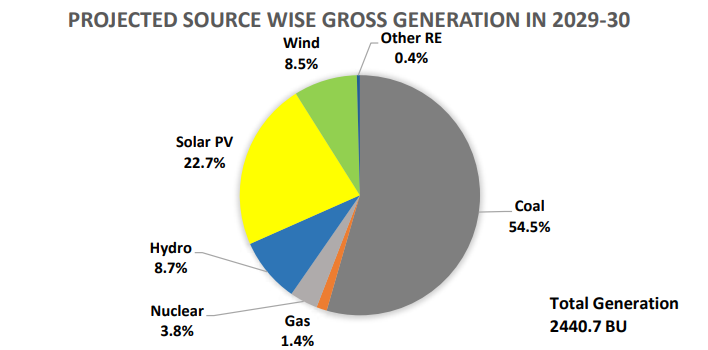CEA Says India’s Solar Generation Capacity to Surpass Thermal by FY 2030
Non-fossil sources to contribute 44% of power generation by FY 2030
May 5, 2023
Follow Mercom India on WhatsApp for exclusive updates on clean energy news and insights
The Central Electricity Authority (CEA) has estimated that India’s solar capacity at 292.6 GW will surpass the thermal generation capacity of 276.5 GW (251.7 GW of coal and 24.8 GW of gas) by the financial year (FY) 2029-30.
The Authority released the estimates in a report on the optimal generation capacity mix for the country.
It said that thermal installed capacity is expected to decrease to 35.5% of the total installed capacity by FY30, from 59% now. Meanwhile, renewable energy installed capacity is projected to increase to 62.4% of the total installed capacity, up from 41%.
The total installed capacity of the power sector in India is projected to reach 777 GW, with 292.6 GW of solar, 100 GW of wind, 53.9 GW of hydropower, 18.9 GW of pumped storage (PSP) and 14.5 GW of biomass power, along with a battery energy storage capacity of 41.7 GW/208.3 GWh.
Coal is expected to contribute 251.7 GW, gas 24.8 GW, and nuclear 15.5 GW.
Coal will continue to be the dominant source of power generation at 54.5% by 2030, even if renewable capacity would be higher than thermal sources.
India’s installed renewable energy capacity, including large hydro projects, stood at 170.32 GW, accounting for a 41% share of the overall power capacity mix at the end of the first quarter of the calendar year 2023.
Source: CEA
The report also estimates that the peak demand and energy requirement will be 334.8 GW and 2279.62 BU, respectively, by 2029-30.
The gross electricity generation is projected to be 2,440.7 BU by FY30, with thermal sources (coal, gas, and lignite) contributing 1,364.5 BU, renewable energy 984 BU, and nuclear power 92.2 BU.
Non-fossil fuels are expected to contribute around 44% to the total electricity generation in FY30.
Solar and Wind
India needs to add 180.4 GW of renewable energy capacity by 2030, which includes 145.9 GW of solar and 34.5 GW of wind, in addition to the current 117 GW (92.5 GW solar and 25 GW wind) in the planning or implementation stage.
Electric vehicles are expected to increase India’s peak demand by 3 GW and energy requirement by 15 BU by FY30.
Rooftop solar installations are estimated to offset all of India’s energy requirement by 34.8 BU, while solar pump installations are estimated to offset 2.4 BU.
The expected capacity utilization factor for solar and wind power in FY30 is 22.97% and 40.8%, respectively.
Battery Energy Storage System (BESS)
The energy storage capacity required for 2029-30 is likely to be 60.63 GW (18.98 GW PSP and 41.65 GW BESS) with storage of 336.4 GWh (128.15 GWh from PSP and 208.25 GWh from BESS)
A PSP-based capacity of 4746 MW currently exists in the country. PSP projects totaling 2780 MW are under construction for likely benefits till 2030. In addition to these projects, a PSP capacity of 11,460 MW is required till 2030 to meet the electricity storage requirements of the country.
Hydropower (including PSP)
The latest assessment by CEA considers a hydropower capacity of 14,274 MW (including 2,780 MW of PSP) currently under construction and likely to yield benefits during FY30.
Additionally, 638 MW of location-specific hydropower projects and 11,460 MW of PSP projects, either concurred by CEA or under the survey and investigation stage, are likely to yield benefits by FY30.
Nuclear
According to the latest Department of Atomic Energy, assessment, 8,700 MW of nuclear capacity is currently under construction, and 7,000 MW of capacity addition has been given in-principle approval.
Coal
Around 26,900 MW of coal capacity under construction is expected to be commissioned by FY30.
A total of 21,240 MW of potential supercritical coal capacity located at pit heads are among candidate plants in development or proposed by various Central and State utilities. Of this, 6,920 MW is currently under bidding.
In addition, if needed, 9,420 MW of coal-based capacity from Central and state sector utilities has been identified for future development. The capital expenditure for new coal plants is ₹83.4 million (~$1.02 million)/MW, up from ₹78.5 million (~$960,697)/MW in earlier studies.
A total of 2,121.5 MW of coal-based capacity is likely to be retired due to non-compliance with the new environmental reforms that require the installation of flue-gas desulfurization systems.
CO2 emissions
The total CO2 emissions increased from 910 million tons in 2020-21 to 1002 million tons in 2021-22. As per the studies, CO2 Emissions from the power sector are likely to increase to 1114 million tons in the year 2029-30
At the recently concluded Mercom Renewables Summit, P K Sinha stated that with the government setting an ambitious goal of 450 GW capacity target by 2030, the renewable sector would easily attract a business of up to $500 billion, out of which $300 billion would be for solar and wind, $50 billion for storage and $150 billion for transmission lines needed to evacuate that power.


